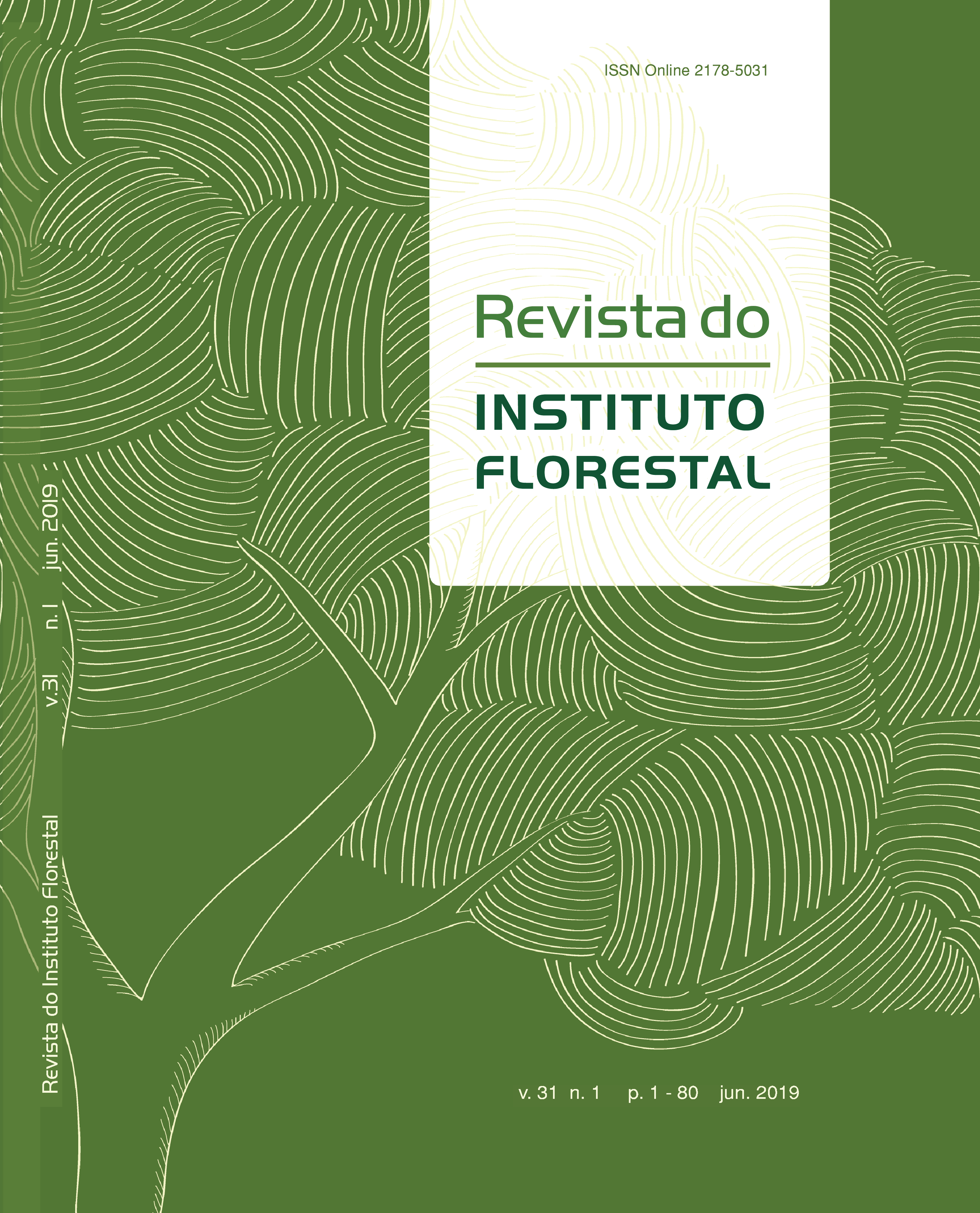THE IMPORTANCE OF SAMPLING ANTHROPIZED AREAS OF ATLANTIC FOREST FOR NEW RECORDS OF WOODY SPECIES1 (SCIENTIFIC NOTE)
DOI:
https://doi.org/10.24278/2178-5031.201931107Palabras clave:
Artocarpus heterophyllus, biological invasion, endemic species, exotic invasive speciesResumen
Phytosociological studies are important for the knowledge of biodiversity patterns and help to elucidate of distribution and abundance of species. We aimed to quantify the wood component in areas that had evident anthropic impacts and presence of exotic and invasive species in Ilha Grande, Rio de Janeiro State, Brazil. The shrubby-tree component with Diameter at Breast Height - DBH ≥ 5cm was quantifed by means of 16 circular plots with 15m radius, of which eight with presence of invasive species Artocarpus heterophyllus Lam. Were identifed 19 new occurrences for Ilha Grande-RJ and two endemic species to the Rio de Janeiro State. We concluded the necessity of quantitative studies in anthropized areas, because these also can conserve biodiversity and are neglected in foristic and phytosociological studies.
Descargas
Citas
ALVES, M.A.S. et al. New records of bird species from Ilha Grande, state of Rio de Janeiro, southeastern Brazil. Check List, v. 12, n. 6, p. 1-11, 2016.
ARAUJO, D.S.D.; OLIVEIRA, R.R. Reserva Biológica Estadual da Praia do Sul (Ilha Grande, Estado do Rio de Janeiro): Lista Preliminar da Flora. Acta Botanica Brasilica, v. 1, n. 2, p. 83-94, 1988.
ASSUMPÇÃO, J.; NASCIMENTO, M.T. Estrutura e composição forística de quatro formações vegetais de restinga no complexo lagunar Grussaí/Iquipari, São João da Barra, RJ, Brasil. Acta Botanica Brasilica, v.14, n. 3, p. 301-315, 2000.
BERGALLO, H.G. et al. Invasion by Artocarpus heterophyllus (Moraceae) in an island in the Atlantic Forest Biome, Brazil: distribution at the landscape level, density and need for control. Journal of Costal Conservation, v. 20, n. 1, p. 1-8, 2016.
CALLADO, C.H. et al. Flora e Cobertura Vegetal. In: BASTOS, M. et al. (Ed.). O Ambiente da Ilha Grande. Rio de Janeiro: Centro de Estudos Ambientais e Desenvolvimento Sustentável - CEADS, 2009. p. 91-162.
CARVALHO, C. Flora: Tools for Interacting with the Brazilian Flora 2020. R package version 0.2.8. http://CRAN.R-project.org/package=fora. 2017.
D’ANTONIO, C.; MEYERSON, L. Exotic Plant Species as Problems and Solutions in Ecological Restoration: A Synthesis. Restoration Ecology, v. 10, n. 4, p. 703–713, 2002.
ESBÉRARD, C.E.L. et al. Morcegos da Ilha Grande, Angra dos Reis, RJ, Sudeste do Brasil. Revista Brasileira de Zoociências, v. 8, n. 2, p. 147-153, 2009.
FORZZA, R.C. et al. New Brazilian foristic list highlights conservation challenges. BioScience, v. 62, n. 1, p. 39-45, 2012.
______. et al. Lista de Espécies da Flora do Brasil. Jardim Botânico do Rio de Janeiro. Available at: <http://foradobrasil.jbrj.gov.br/2012/>. Accessed in: 30 jan. 2017.
HOBBS, R.J. et al. Novel ecosystems: theoretical and management aspects of the new ecological world order. Global Ecology and Biogeography, v. 15, p. 1-7, 2006.
JABOT - Banco de Dados da Flora Brasileira.
JBRJ - Instituto de Pesquisas Jardim Botânico do Rio de Janeiro. Available at: <http://www.jbrj.gov.br/jabot>. Accessed in: 26 jan 2017.
LOPES, L.C.M.; MARIANO-NETO, E.; AMORIM, A.M.A. Estrutura e composição forística da comunidade lenhosa do sub-bosque em uma foresta Tropical no Brasil. Boletim do Museu de Biologia Mello Leitão, v. 37, n. 4, p. 361-391, 2015.
LUGO, A.E. The outcome of alien tree invasions in Puerto Rico. Frontier Ecology Environment, v. 2, n. 5, p. 265–273, 2004.
MARQUES, M.C.M. et al. Mata Atlântica – O Desafo de transformar um passado de devastação em um futuro de conhecimento e conservação. In: PEIXOTO, A.L. et al. (Ed.). Conhecendo a Biodiversidade. Brasília: Ministério de Ciência e Tecnologia, Inovações e Comunicações: Editora Vozes, 2016. p. 50-67.
MARTINI, A.M.Z. et al. A hot-point within a hot-spot: a high diversity site in Brazil’s Atlantic Forest. Biodiversity and Conservation, v. 16, n. 11, p. 3111-3128, 2007.
MORIM, M.P. Pseudopiptadenia. In: Lista de Espécies da Flora do Brasil. Jardim Botânico do Rio de Janeiro. 2015. Available at: <http://foradobrasil.jbrj.gov.br/jabot/foradobrasil/FB23130>. Accessed in: 26 jan 2017.
MORO, M.F. et al. Alienígenas na sala: o que fazer com espécies exóticas em trabalhos de taxonomia, forística e ftossociologia? Acta Botanica Brasilica, v. 26, n. 4, p. 991-999. 2012.
MYERS, N. et al. Biodiversity hotspots for conservation priorities. Nature, v. 403, n. 6772, p. 853-858, 2000.
OLIVEIRA, R.R. Ação antrópica e resultantes sobre a estrutura e composição da Mata Atlântica na Ilha Grande, RJ. Rodriguesia, v. 53, n. 82, p. 33-58, 2002.
OLIVEIRA-FILHO, A.T.; FONTES, M.A.L. Patterns of foristic differentation among Atlantic Forest in south-eastern Brazil, and the infuence of climate. Biotropica, v. 32, n. 4b, p. 793-810, 2000.
PYŠEK, P. et al. Alien plants in checklists and foras: towards better communication between taxonomists and ecologists. 2004. Taxon, v. 53, p. 131-143, 2004.
R CORE TEAM. R: A language and environment for statistical computing. R Foundation for Statistical Computing, Vienna, Austria. URL< https://www.R-project.org/.> 2015.
RIBEIRO, M.C. et al. The Brazilian Atlantic Forest: How much is left, and how is the remaining forest distributed? Implications for conservation. Biological Conservation, v. 142, n. 6, p. 1141-1153, 2009.
RICHARDSON, D.M. et al. Naturalization and invasion of alien plants: concepts and definitions. Diversity and Distribution, v. 6, n. 2, p. 93-107, 2000.
ROCHA, C.F.D. et al. A Fauna de ambientes anteriores. In: BASTOS, M. et al. (Ed.). O Ambiente da Ilha Grande. Rio de Janeiro: Centro de Estudos Ambientais e Desenvolvimento Sustentável - CEADS, 2009. p. 163-246.
SCARANO, F.R. Structure, function and foristic relationships of plant communities in stressful habitats marginal to the Brazilian Atlantic rainforest. Annals of Botany, v. 90, p. 517-524, 2002.
______. Prioridades para Conservação: a linha tênue que separa teorias e dogmas. In: ROCHA, C.F.D. et al. (Ed.). Biologia da Conservação: Essências. São Carlos: Editora RIMA, 2006. p. 299-313.
______.; CEOTTO, P. Brazilian Atlantic forest: impact, vulnerability, and adaptation to climate change. Biodiversity and Conservation, v. 24, p. 2319–2331, 2015.
SMITH, N.P. et al. Conservation assessment of Lecythidaceae from eastern Brazil. Kew Bulletim, v. 71, n. 1, p. 1-19, 2016.
ZAPPI, D.C. et al. Growing knowledge: an overview of Seed Plant diversity in Brazil. Rodriguesia, v. 66, n. 4, p. 1085-1113, 2015.
















